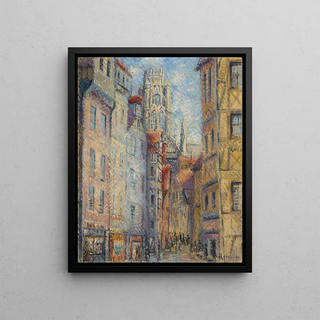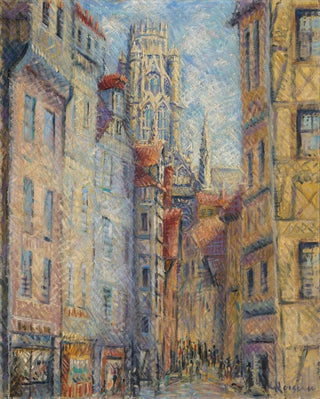Art print | Rouen Street with the church - Gustave Loiseau


View from behind

Frame (optional)
Art print Rouen Street with the church - Gustave Loiseau – Captivating introduction
In the vast panorama of French Impressionism, the work "Rouen Street with the church" by Gustave Loiseau emerges as a delicate window into early 20th-century urban life. This piece, imbued with light and color, invites the viewer to immerse themselves in a vibrant atmosphere where each brushstroke seems to capture the very essence of passing time. The artist, choosing to depict the city of Rouen, does not merely portray a simple landscape but evokes a lively, almost animated scene, where the Gothic architecture of the church stands majestically amidst the hustle and bustle of city life. This painting, a true ode to everyday beauty, still resonates today, offering an invitation to contemplation and wonder.
Style and uniqueness of the work
Gustave Loiseau's style is distinguished by a palette of vibrant colors and bold treatment of light. In "Rouen Street with the church," warm hues and delicate nuances intertwine to create an atmosphere that is both peaceful and dynamic. Shadows dance on the cobblestones, while sunbeams filter through the clouds, illuminating the facades of buildings. This play of light is characteristic of Impressionism, but Loiseau adds a personal touch, a keen sense of composition that guides the viewer's eye across the canvas. Every element, whether it be characters strolling in the street or architectural details of the church, is treated with meticulous care that reflects his deep respect for his subject. This work, through its ability to evoke emotions and tell a story, positions itself as a true masterpiece of the Impressionist movement.
The artist and his influence
Gustave Loiseau, born in 1865, was an artist whose journey was marked by an unceasing quest for beauty and truth through painting. Influenced by his contemporaries, he developed a style that was uniquely his own, oscillating between realism and Impressionism. His fascination with light and color drove him to explore various landscapes, but it is in the

Matte finish

View from behind

Frame (optional)
Art print Rouen Street with the church - Gustave Loiseau – Captivating introduction
In the vast panorama of French Impressionism, the work "Rouen Street with the church" by Gustave Loiseau emerges as a delicate window into early 20th-century urban life. This piece, imbued with light and color, invites the viewer to immerse themselves in a vibrant atmosphere where each brushstroke seems to capture the very essence of passing time. The artist, choosing to depict the city of Rouen, does not merely portray a simple landscape but evokes a lively, almost animated scene, where the Gothic architecture of the church stands majestically amidst the hustle and bustle of city life. This painting, a true ode to everyday beauty, still resonates today, offering an invitation to contemplation and wonder.
Style and uniqueness of the work
Gustave Loiseau's style is distinguished by a palette of vibrant colors and bold treatment of light. In "Rouen Street with the church," warm hues and delicate nuances intertwine to create an atmosphere that is both peaceful and dynamic. Shadows dance on the cobblestones, while sunbeams filter through the clouds, illuminating the facades of buildings. This play of light is characteristic of Impressionism, but Loiseau adds a personal touch, a keen sense of composition that guides the viewer's eye across the canvas. Every element, whether it be characters strolling in the street or architectural details of the church, is treated with meticulous care that reflects his deep respect for his subject. This work, through its ability to evoke emotions and tell a story, positions itself as a true masterpiece of the Impressionist movement.
The artist and his influence
Gustave Loiseau, born in 1865, was an artist whose journey was marked by an unceasing quest for beauty and truth through painting. Influenced by his contemporaries, he developed a style that was uniquely his own, oscillating between realism and Impressionism. His fascination with light and color drove him to explore various landscapes, but it is in the






